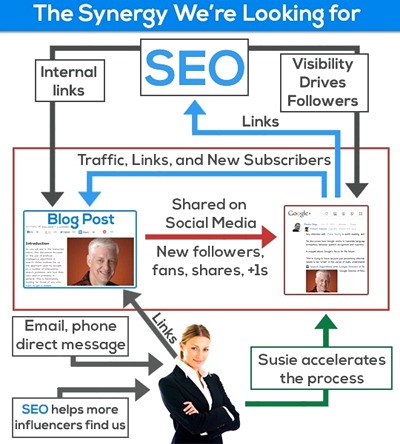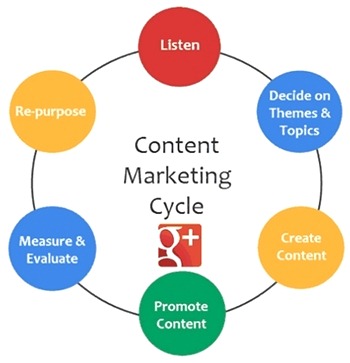Smart Content Strategy - Saying What Has To Be Said
This is a guest post by James Bradrick
“Sometimes, reaching out and taking someone's hand is the beginning of a journey”. Vera Nazarian
When we reach a decision concerning exactly what we are going to communicate we have also begun a journey called content strategy. And in a very real way we have begun to reach out to those we wish to communicate with.
That decision defines the ‘what’ of our endeavours. Following that we can consider the ‘who’ - that is, social media strategy and later the ‘how’ - which is copywriting strategy. However the first step is necessarily understanding the ‘what’.
The elements of content strategy can be analyzed by using the words who, what, when, where and why.
These 5 words define the demographics of our intended audience. By clearly understanding who our audience is an effective marketing plan can be devised.
The Elements of Content Strategy
- Who - What specific segment of society? Artists? Welders? New car buyers?
- What - What do they have in common? What interconnects them? Age? Nationality? Common cause? How do they define themselves?
- When - When could we reach out to them and find them the most receptive to our messages?
- Where - Where are they? What common locale bind them together?
- Why - Why would they listen to us? How can we tailor our message to meet their needs and intrigue them?

How does our target audience stays informed? What social media platforms do they use?
Social Media Strategy
With the answer to these questions we can begin to structure our message in a meaningful way. The format of our message will be defined by the principle ways that our audience informs itself. Printed publications, documentaries, email, videos and Google Plus are just a few of the possible platforms that our audience could use. It follows that our message will need to be structured for those particular platforms.
What are the communication nuances of our audience? A Midwestern wheat farmer will communicate in a manner that is different from, say, a young professional living in Brooklyn or a UCLA Freshman student. For effective and persuasive communication we should communicate in much the same manner as our listeners and subtly suggest what we want them to observe.
Once these are clearly understood we can begin to format our message.
We now know exactly who we are reaching out to and how to meet them at their level.
Branding
From the outset we have known how we want to influence our audience. Whether this is buying the latest car or signing up for our newsletter we must now examine what we are offering them and put our best foot forward. At the moment this move is not to persuade them but to embed in their minds an unforgettable and positive image of us.
A very clear understanding of our brand becomes important. Can we reduce our brand to as few as 2 words? Those 2 words don’t need to be a coherent message however they should reflect the lowest common denominator of our brand. Once this have been defined then other words can be added to form a congruent sentence that can be stated in 1 breath.
This congruent sentence will be the core element of our message. We may or may not use this sentence in our presentation however it is almost always the basic philosophy behind our message.
And once we have embedded our brand in the mind of the public, that brand will automatically be associated with whatever message we might be presenting. The two will always be seen as one.
Social media strategy now begins to merge into to our efforts to get our message across. By reflecting upon the 5 W’s of our target audience we can begin fashioning our presentation by choosing the social media platforms that appeal to the largest segment of our target. This then defines the style of our message and we can begin to craft the actual messages themselves.
Copywriting Strategy
By consulting marketing research we can determine how our audience is searching for what we are offering and tailor our messages using the same language. Thus communicating on the same level as our target.
In the above we have seen how content strategy has gradually merged into social media strategy and then flowed further to involve copywriting strategy. The latter only coming into play after the first 2 are firmly defined. After crafting several different presentations testing is then conducted to determine which specific message elicits the most desirable responses from our target. 
Only then do we know if we are accomplishing our marketing objectives for it is the public who decides what they pay attention to. This process of testing is often called “rinse and repeat” and is an ongoing and integral part of our content strategy. Using what doesn’t work is of little benefit to anyone.
We are now actively engaged in communicating with the public. If we are offering products and services that they, the public, need we are well on our way to a win-win situation.
Subliminal persuasion is a fascinating look into the psychology of marketing. By understanding how and why people think the way they do, it becomes possible to motivate them to pursue almost anything. Which can be undesirable if the person doing the persuading is someone like Adolf Hitler. You get the point.
The fact remains however that people can be influenced to act in responsible and positive ways. Please, look beyond the dollar sign.
About the author
James Bradrick writes awesome content for those who don’t want to.
6 comments to "Smart Content Strategy - Saying What Has To Be Said"
great strategy ! ..
i like your post .. it awesome . thanks for sharing master :)
Hi Rian, Thanks for reading and your kind words.
wow, another great articles, proud to say i'm subscribe yo tou..
Hi,
You have shared very good points,
Specially branding.
dewey,
Thanks for reading and I'm glad you enjoyed it.
Ujjwal Sen,
Thanks for your kind words. Really, I think that branding is at the very core of content strategy. For without a clearly defined "what are we doing and why" it becomes very difficult indeed to create any sort of intelligent content.
Post a Comment
We love to hear from you! Leave us a comment.
To ensure proper display, HTML/XML/Javascript need to be escaped first using this escape tool.